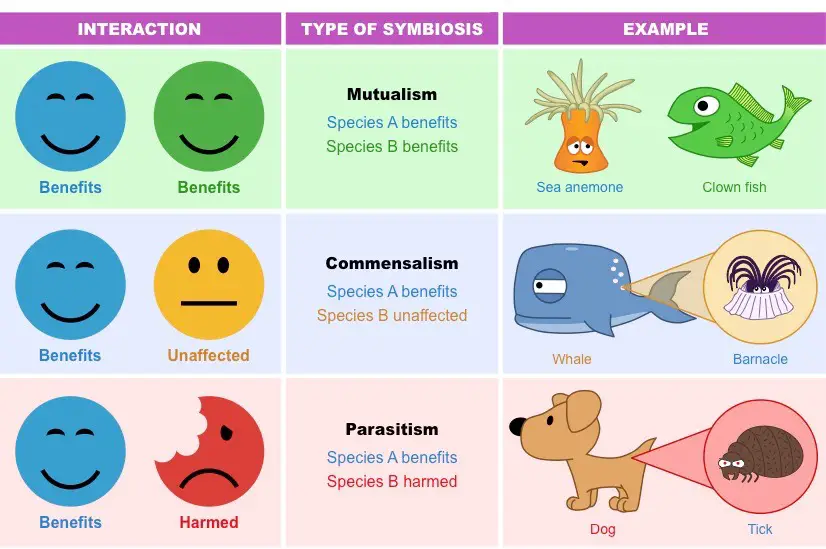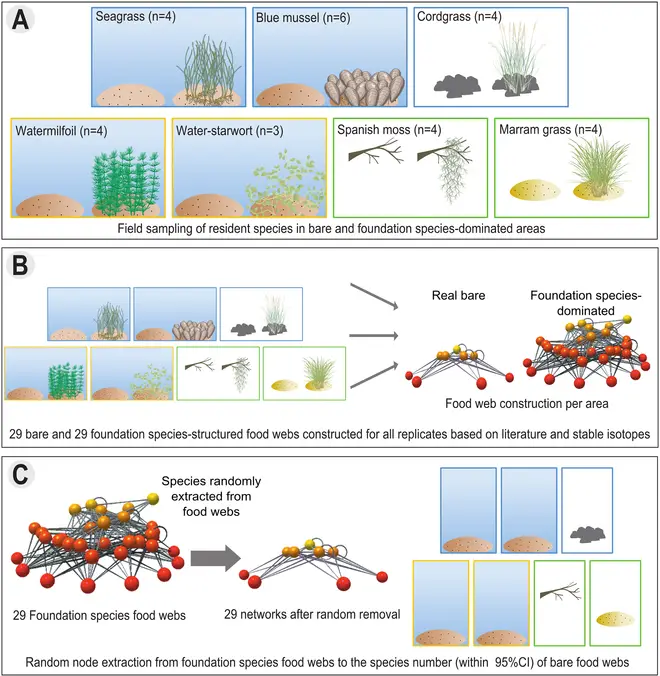Advertisements
Table of Contents
- A biological interaction in ecology is the influence that two creatures living in the same community have on each other.
- They can be of the same species (intraspecific interactions) or of other species (interspecific interactions) (interspecific interactions).
- Both short-term and long-term effects, such as pollination and predation, frequently have a substantial impact on the evolution of the species involved. A long-term relationship is known as symbiosis.
- Symbioses range from mutualism, which is advantageous for both partners, to competition, which is detrimental for both parties.
- Through intermediaries such as shared resources or common foes, interactions might be indirect. This type of interaction can be demonstrated by net effects depending on the individual effects of the relationship on both organisms.
- Recent research suggests that non-trophic species interactions, such as habitat alteration and mutualisms, can play a significant role in determining food web patterns.
- It remains unclear, however, whether these findings are applicable to all ecosystems and whether non-trophic interactions alter food webs arbitrarily or affect particular trophic levels or functional groupings.
Short-term interactions
- In ecology and evolution, short-term interactions, such as predation and pollination, are particularly significant.
- These relationships are short-lived in terms of the period of a single interaction: a predator kills and consumes its victim; a pollinator transports pollen from one flower to another; but, their influence on the development of both partners is highly long-lasting. Due of this, the partners coevolve.
1. Predation
- In predation, a member of one species—the predator—consumes a portion or the entire living or recently deceased body of another species—the prey.
- This interaction (+/-) is advantageous for the predator but detrimental for the victim. Herbivory is a subtype of predation in which an animal or insect consumes a plant.
- Predators and prey govern the population dynamics of each other. In addition, many species with predator-prey relationships have acquired adaptations, or advantageous characteristics resulting from natural selection, that are tied to their interaction.
- These include mechanical, chemical, and behavioural defences employed by the prey.
- Some animals also have colour that signals potential predators to their defences; other species that are harmless may imitate this coloration.
- In the process of predation, one creature, the predator, kills and consumes another, the prey. With keen senses such as vision, hearing, and smell, predators are suited and frequently highly specialised for hunting.
- Many predatory species, both vertebrate and invertebrate, are equipped with sharp claws or jaws to capture, kill, and dismember their prey.
- Other adaptations, like as stealth and aggressive imitation, boost the effectiveness of hunting.
- Predation causes prey to develop antipredator adaptations such as warning colouring, alarm sounds and other signals, camouflage, protective spines, and defensive chemicals.
- At least since the Cambrian period, predation has been a primary driver of evolution.
Example of Predation
- Carnivorous interactions are the most well-known examples of predation, in which one species consumes another. Consider wolves hunting elk, owls hunting mice, and shrews hunting insects and worms.
- Spiders weave webs to capture and kill insects.
- Lacewings that feed on mites and tiny caterpillars.
- With its deadly stinger, scorpions destroy insects and small mammals.
- Octopi capture fish and crustaceans.
- Aphid-eating ladybugs on apple trees and rose bushes
- Mantises feed on an assortment of insects, including crickets and other mantises.
- Yellowjackets and wasps are attacking house fly nests in order to consume their larvae.
- Fire ants transporting earthworms, caterpillars, and insect eggs to their anthills during swarming.
- In the ocean, mollusks and shrimp feed on zooplankton.
- Large quantities of fish consumed by tuna from schools.
- Piranhas in a frenzy to consume a larger fish or animal.
- Lionfish assault vast populations of reef fish
- Predating and murdering other fish, birds, or marine animals are sharks.
- Moray eels that hide and prey on smaller fish
- As they swim, manta rays capture little fish in their mouths.
2. Pollination
- In pollination, pollinators such as insects (entomophily), some birds (ornithophily), and some bats transport pollen from a male floral part to a female flower part in exchange for pollen or nectar.
- Throughout geological time, the partners have coevolved; in the case of insects and blooming plants, the coevolution has persisted for more than 100 million years.
- Insect-pollinated flowers are equipped with structured structures, brilliant colours, patterns, perfume, nectar, and sticky pollen in order to attract insects, direct them to collect and deposit pollen, and reward them for their service.
- Pollinator insects such as bees are specialised to recognise flowers by colour, pattern, and fragrance, to collect and transport pollen (such as using pollen basket-shaped bristles on their hind legs), and to collect and process nectar (in the case of honey bees, making and storing honey).
- The modifications on both side of the interaction are symmetrical and have been sculpted by natural selection based on their pollination efficiency.
Example of Pollination
- Pollinators include birds, bats, butterflies, moths, flies, beetles, wasps, tiny mammals, and most significantly, bees. They visit flowers to consume nectar or pollen and transfer pollen grains as they travel from location to location.
3. Seed dispersal
- The movement, dispersion, or transfer of seeds away from the parent plant is known as seed dispersal. Plants have limited mobility and rely on a range of dispersal vectors, including abiotic vectors like the wind and live (biotic) vectors like birds, to carry their propagules.
- Individually or collectively, seeds can be distributed away from the parent plant, as well as in both space and time.
- This has significant ramifications for the demographic and genetic structure of plant populations, migration patterns, and species interactions, as well as the patterns of seed distribution.
- There are five primary seed distribution mechanisms: gravity, wind, ballistic, water, and animals.
- Some plants are serotinous and only distribute their seeds in reaction to a stimulation from the environment.
- Dispersal entails the release or separation of a diaspore from the parent plant.
Example of Seed dispersal
- Orchid seeds, dandelion seeds, swan plant seeds, cottonwood tree seeds, hornbeam seeds, ash seeds, cattail seeds, puya seeds, and willow herb seeds are all examples of plants whose seeds are dispersed by the wind. In this type of seed dispersal, the seeds are carried away from their parent plant by floating.
Symbiosis: long-term interactions
Mutualism, commensalism, parasitism, neutralism, amensalism, and competition are the six forms of symbiosis. These are distinguished by the extent to which they benefit or hurt each partner.

1. Competition
- In interspecific competition, members of two distinct species that utilise the same scarce resource compete for it.
- Competition is an interaction between individuals or species in which the fitness of one is diminished due to the presence of another.
- Typically, competition is over limited resources such as food, water, or territory, or for access to females for reproduction.
- Intraspecific competition refers to competition between members of the same species, whereas interspecific competition refers to competition between members of different species.
- According to the idea of competitive exclusion, animals less adapted to compete for resources should either adapt or become extinct.
- According to the theory of evolution, this rivalry between and within species for resources is a crucial factor in natural selection.
- Competition has a detrimental impact on both parties (-/- interaction), as the survivability and reproduction of either species would be greater in the absence of the other.
- Species compete when they share ecological responsibilities and requirements for life and reproduction, often known as niches.
- If two species with overlapping niches develop through natural selection to utilise fewer similar resources, resulting in resource partitioning, competition can be reduced.
Example of Competition
- Different plant species produce a variety of chemical compounds that inhibit the growth of other plants of the same species.
- Around plants, the rivalry between creatures is typically for space, nutrients, and water.
- The plant generates chemical compounds, such as phytotoxins, that are toxic to organisms of the same species.
2. Symbiosis
- Symbiosis is the broad term for interspecific interactions in which two species live in an intimate, long-term relationship.
- In ordinary language, symbiosis is sometimes used to describe a partnership that benefits both parties.
- However, in the language of ecologists, symbiosis is a broader word that can encompass close, long-lasting partnerships with a variety of good or negative impacts on the members.
Example of Symbiosis
- Examples of symbiosis include Lactobacillus and humans, cells and mitochondria, ants and fungi, goby fish and snapping shrimp, coral and algae, and cleaner fish.
3. Mutualism
- Mutualism is a relationship between two or more species in which both species benefit, such as by increasing their carrying capacity.
- Cooperation refers to comparable interactions within a species. Mutualism can be categorised according to the degree of association, with symbiosis, which is frequently confused with mutualism, being the most intimate.
- One or both of the interacting species may be obligatory, meaning they cannot exist in the short or long term without the other.
- Mutualism, despite traditionally receiving less attention than other relationships such as predation, is a crucial topic in ecology.
Example of Mutualism
- Cleaning symbiosis, intestinal flora, Müllerian mimicry, and nitrogen fixation by bacteria in the root nodules of legumes are examples.
4. Commensalism
- In commensalism, two species engage in a long-term relationship that is advantageous to one but has no effect on the other (+/0 interaction).
- Commensalism is beneficial to one organism while the other is neither benefited nor injured.
- It occurs when one organism gains benefits from interacting with another organism without affecting the host organism.
Example of Commensalism
- A excellent example is the coexistence of a remora and a manatee. Remoras consume manatee excrement. This connection has no effect on the manatee because the remora does not drain the manatee’s supplies.
5. Parasitism
- In parasitism, two species engage in a close, long-lasting relationship that is advantageous to the parasite and detrimental to the host (+/- interaction).
- Some parasites induce familiar human diseases. If you have a tapeworm in your intestine, you are the host and the tapeworm is the parasite; your presence improves the tapeworm’s quality of life, but not vice versa!
Example of Parasitism
- Examples of parasitism include helminths (worms) in the host’s intestines, lice (Pediculus humanus capitis) on the human head, and Plasmodium species carried by anopheline mosquitoes and causing human malaria.
6. Neutralism
- Neutralism (a term coined by Eugene Odum) refers to the relationship between two species that interact but have no effect on one another.
Example of Neutralism
- True examples of neutralism are nearly impossible to demonstrate; in practise, the phrase refers to situations in which interactions are minor or inconsequential.
7. Amensalism
- Amensalism (a concept coined by Haskell) is an interaction in which one organism inflicts harm on another without incurring any costs or receiving any advantages.
- Amensalism refers to the negative impact that one organism has on another.
- This is a unidirectional process in which one organism releases a specific substance that has a harmful effect on another.
- The microbial synthesis of antibiotics that can inhibit or kill other sensitive germs is a classic example of amensalism.
- Sheep and cattle trampling grass is an obvious example of amensalism. While the presence of grass has little negative consequences on the animal’s hoof, the grass is negatively affected by being crushed.
- Amensalism is frequently used to characterise highly asymmetrical competitive interactions, such as those observed between the Spanish ibex and Timarcha weevils that feed on the same type of plant.
- While the presence of weevils has a negligible effect on food availability, the presence of ibex has a devastating effect on weevil populations, as ibex devour large quantities of plant matter and unintentionally consume weevils along with it.
- Amensalisms can be fairly intricate. Attine ants (New World ant tribe) are able to profit from the interaction between an actinomycete and a parasite fungus of the genus Escovopsis.
- This amensalistic interaction permits the ant to sustain a mutualistic relationship with members of the Leucocoprinus genus. Amazingly, these ants develop a Leucocoprinus fungus garden for their own sustenance.
- Ants support the growth of an actinomycete of the genus Pseudonocardia, which produces an antibiotic chemical that inhibits the growth of the parasitic Escovopsis fungi.
Example of Amensalism
- When livestock trampling on grass, the grass is trampled. However, neither the cattle nor the process gain from this action. Antibiosis is illustrated by the relationship between Penicillium and bacteria.

Non-trophic interactions
- Non-trophic interactions might include habitat alteration, mutualism, and space rivalry.
- Recent research suggests that non-trophic interactions might indirectly influence food web structure and trophic dynamics by influencing the network species and the strength of trophic linkages.
- Recent theoretical research has stressed the importance of integrating trophic and non-trophic interactions in ecological network investigations.
- Food web structures (network topologies) may be significantly influenced by species interactions occurring outside of the trophic network, according to the scant empirical research on this topic.
- However, these studies only contain a small number of coastal systems, and it is unclear to what degree these findings are generalizable. Whether non-trophic interactions typically influence particular species, trophic levels, or functional groupings within the food web, or, conversely, mediate species and their trophic relationships throughout the network, remains unknown.
- Some research indicate that sessile species with relatively low trophic levels appear to gain the most from non-trophic facilitation, however other studies indicate that facilitation also benefits species with higher trophic levels and greater mobility.
- Borst et al. (2018) examined the basic hypothesis that foundation species — geographically dominant habitat-structuring creatures — affect food webs by increasing their size, as measured by species number, and their complexity, as measured by link density, via facilitation of species (see diagram).
- In addition, they examined whether any change in the properties of the food web caused by foundation species results from the random facilitation of species throughout the entire food web or from the targeted facilitation of specific species that belong to particular trophic levels or functional groups.
- It was discovered that species at the base of the food web are less strongly facilitated than predicted by random facilitation, while carnivores are more strongly facilitated in the food webs of foundation species, resulting in a higher mean trophic level and a longer average chain length.
- This suggests that foundation species increase the complexity of food webs by non-trophic stimulation of species throughout the entire trophic network.
- Despite the fact that foundation species are a part of the food chain just like any other species (e.g., as prey or predator), multiple studies have demonstrated that by establishing new habitat and reducing physical stress, they greatly benefit the related population.
- It has been discovered that this sort of non-trophic facilitation by foundation species occurs in a vast array of habitats and environmental situations.
- In difficult coastal zones, corals, kelps, mussels, oysters, seagrasses, mangroves, and salt marsh plants aid species by dampening currents and waves, providing aboveground structure for protection and attachment, concentrating nutrients, and/or minimising desiccation stress during low tide exposure.
- Foundation species, such as trees in a forest, shrubs and grasses in savannahs, and macrophytes in freshwater systems, have also been found to play a vital role in habitat structure in more benign ecosystems.
- In the end, all foundation species improve habitat complexity and availability, ultimately dividing and expanding niche space for other species.

| Competition | Competition is an interaction between individuals or species in which the fitness of one is diminished due to the presence of another. |
| Symbiosis | Symbiosis is the broad term for interspecific interactions in which two species live in an intimate, long-term relationship. |
| Mutualism | Mutualism is a relationship between two or more species in which both species benefit, such as by increasing their carrying capacity. |
| Commensalism | In commensalism, two species engage in a long-term relationship that is advantageous to one but has no effect on the other (+/0 interaction). |
| Parasitism | In parasitism, two species engage in a close, long-lasting relationship that is advantageous to the parasite and detrimental to the host (+/- interaction). |
| Neutralism | Neutralism (a term coined by Eugene Odum) refers to the relationship between two species that interact but have no effect on one another. |
| Amensalism | Amensalism (a concept coined by Haskell) is an interaction in which one organism inflicts harm on another without incurring any costs or receiving any advantages. |
References
- Mittelbach, Gary G., and Brian J. McGill, ‘Beneficial interactions in communities: mutualism and facilitation’, Community Ecology, 2nd edn (Oxford, 2019; online edn, Oxford Academic, 19 Sept. 2019), https://doi.org/10.1093/oso/9780198835851.003.0009, accessed 3 Oct. 2022.
- Bertness MD, Callaway R. Positive interactions in communities. Trends Ecol Evol. 1994 May;9(5):191-3. doi: 10.1016/0169-5347(94)90088-4. Epub 2003 Nov 7. PMID: 21236818.
- Simmons, B. I., Wauchope, H. S., Amano, T., Dicks, L. V., Sutherland, W. J., & Dakos, V. (2020). Estimating the risk of species interaction loss in mutualistic communities. PLOS Biology, 18(8), e3000843. doi:10.1371/journal.pbio.3000843
- https://learn-biology.com/ap-biology/community-ecology-main-menu/community-ecology-1-species-interactions/
- https://userpages.umbc.edu/~farabaug/community.html
- https://ib.bioninja.com.au/standard-level/topic-4-ecology/41-species-communities-and/species-interactions.html
- Mougi, A., & Kondoh, M. (2012). Diversity of Interaction Types and Ecological Community Stability. Science, 337(6092), 349–351. doi:10.1126/science.1220529
- https://www.ecologycenter.us/natural-history-2/positive-interactions.html
- https://www.bisd303.org/cms/lib/WA01001636/Centricity/Domain/614/Ch04-Reading%20Guide-Answers.pdf
- https://openbooks.lib.msu.edu/isb202/chapter/species-interactions/
- https://www.toppr.com/ask/question/why-are-community-interactions-important/
- https://ctb.ku.edu/en/table-of-contents/implement/physical-social-environment/places-for-interaction/main
- https://www.nature.com/scitable/knowledge/library/species-interactions-and-competition-102131429/
- https://opencurriculum.org/5382/community-interactions-in-ecosystems/
- https://www.ck12.org/book/ck-12-biology/section/12.1/
- https://www.globalchange.umich.edu/globalchange1/current/lectures/ecol_com/ecol_com.html
- https://www.sscollegejehanabad.org/study-material/1987191961Biological%20Interaction%20in%20Ecology%20(pg)_Ecology_Zoology_Praveen.pdf
- http://www.skanschools.org/tfiles/folder471/chapter%205-6%20review%20notes.pdf
- https://www.boyertownasd.org/cms/lib/PA01916192/Centricity/Domain/743/C.%20Chapter%209%20Lesson%209.3-Interactions%20and%20Relationships%20in%20an%20Ecosystem.pdf
- https://www.slideshare.net/wja10255/community-interactions-9557804
- http://www.zo.utexas.edu/faculty/pianka/indirect.html
- http://legacy.hopkinsville.kctcs.edu/instructors/Jason-Arnold/VLI/VLI/VLI818/M4BCommunitiesandecosystems/M4BCommunitiesandecosystems3.html
- https://www.rrcs.org/Downloads/Interations%20within%20Communities.pdf
- https://www.science.org/doi/10.1126/science.1220529?cookieSet=1


